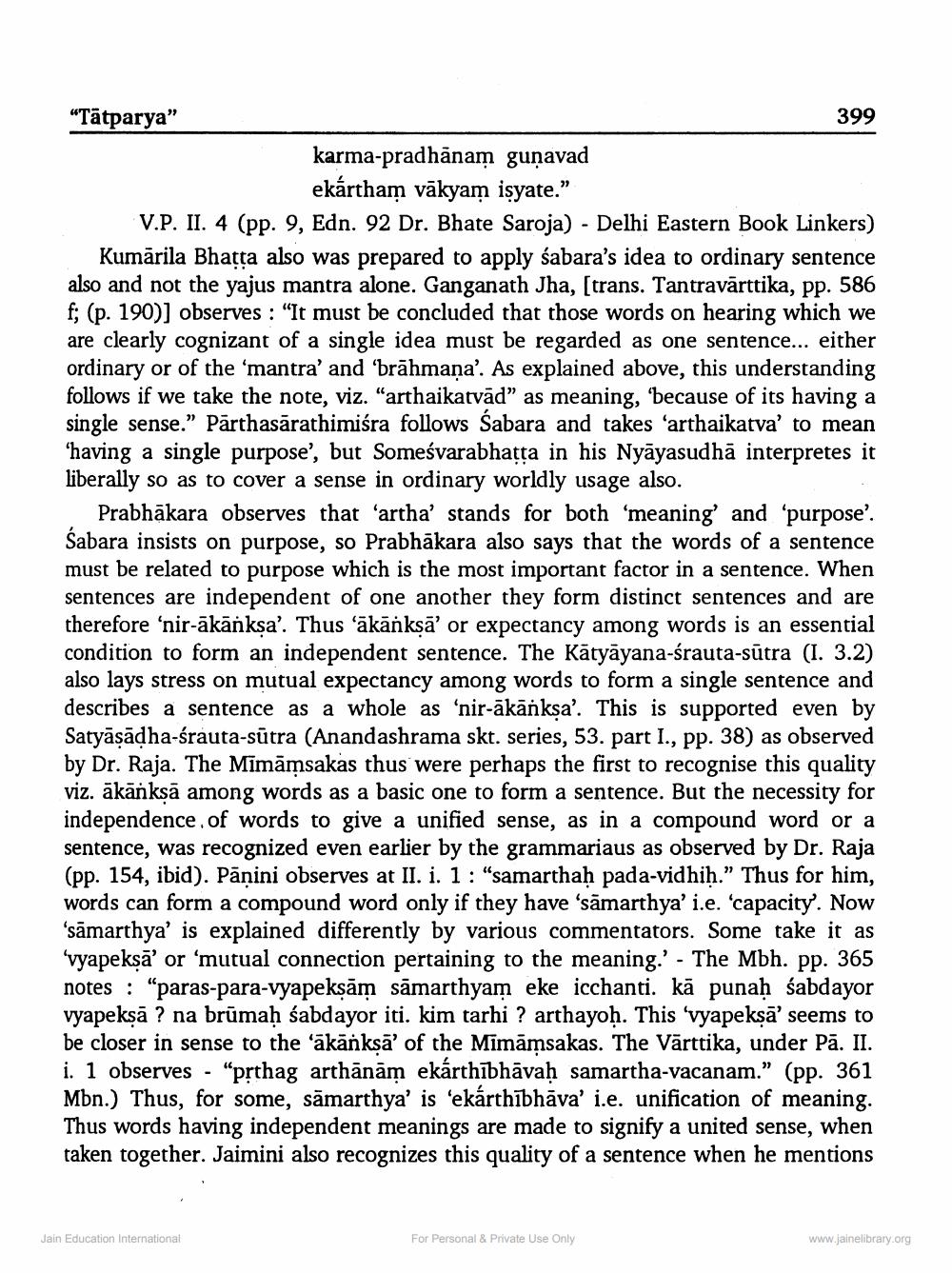________________
"Tätparya"
karma-pradhānam guṇavad ekártham vākyam isyate."
V.P. II. 4 (pp. 9, Edn. 92 Dr. Bhate Saroja) - Delhi Eastern Book Linkers) Kumārila Bhaṭṭa also was prepared to apply śabara's idea to ordinary sentence also and not the yajus mantra alone. Ganganath Jha, [trans. Tantravārttika, pp. 586 f; (p. 190)] observes: "It must be concluded that those words on hearing which we are clearly cognizant of a single idea must be regarded as one sentence... either ordinary or of the 'mantra' and 'brāhmaṇa'. As explained above, this understanding follows if we take the note, viz. "arthaikatvad" as meaning, 'because of its having a single sense." Parthasarathimiśra follows Śabara and takes 'arthaikatva' to mean 'having a single purpose', but Someśvarabhaṭṭa in his Nyāyasudhā interpretes it liberally so as to cover a sense in ordinary worldly usage also.
399
Prabhakara observes that 'artha' stands for both 'meaning' and 'purpose'. Sabara insists on purpose, so Prabhakara also says that the words of a sentence must be related to purpose which is the most important factor in a sentence. When sentences are independent of one another they form distinct sentences and are therefore 'nir-ākānkṣa'. Thus 'ākānkṣā' or expectancy among words is an essential condition to form an independent sentence. The Katyayana-śrauta-sūtra (I. 3.2) also lays stress on mutual expectancy among words to form a single sentence and describes a sentence as a whole as 'nir-ākānkṣa'. This is supported even by Satyāṣāḍha-śrauta-sūtra (Anandashrama skt. series, 53. part I., pp. 38) as observed by Dr. Raja. The Mīmāmsakas thus were perhaps the first to recognise this quality viz. ākānkṣā among words as a basic one to form a sentence. But the necessity for independence. of words to give a unified sense, as in a compound word or a sentence, was recognized even earlier by the grammariaus as observed by Dr. Raja (pp. 154, ibid). Panini observes at II. i. 1: "samarthaḥ pada-vidhih." Thus for him, words can form a compound word only if they have 'samarthya' i.e. 'capacity'. Now 'sāmarthya' is explained differently by various commentators. Some take it as 'vyapekṣā' or 'mutual connection pertaining to the meaning.' - The Mbh. pp. 365 notes: "paras-para-vyapekṣām sāmarthyam eke icchanti. kā punaḥ śabdayor vyapekṣā? na brūmaḥ śabdayor iti. kim tarhi ? arthayoḥ. This 'vyapekṣā' seems to be closer in sense to the 'ākānkṣa' of the Mimamsakas. The Vārttika, under Pā. II. i. 1 observes - "pṛthag arthānām ekárthībhāvaḥ samartha-vacanam." (pp. 361 Mbn.) Thus, for some, samarthya' is 'ekárthībhāva' i.e. unification of meaning. Thus words having independent meanings are made to signify a united sense, when taken together. Jaimini also recognizes this quality of a sentence when he mentions
Jain Education International
For Personal & Private Use Only
www.jainelibrary.org




